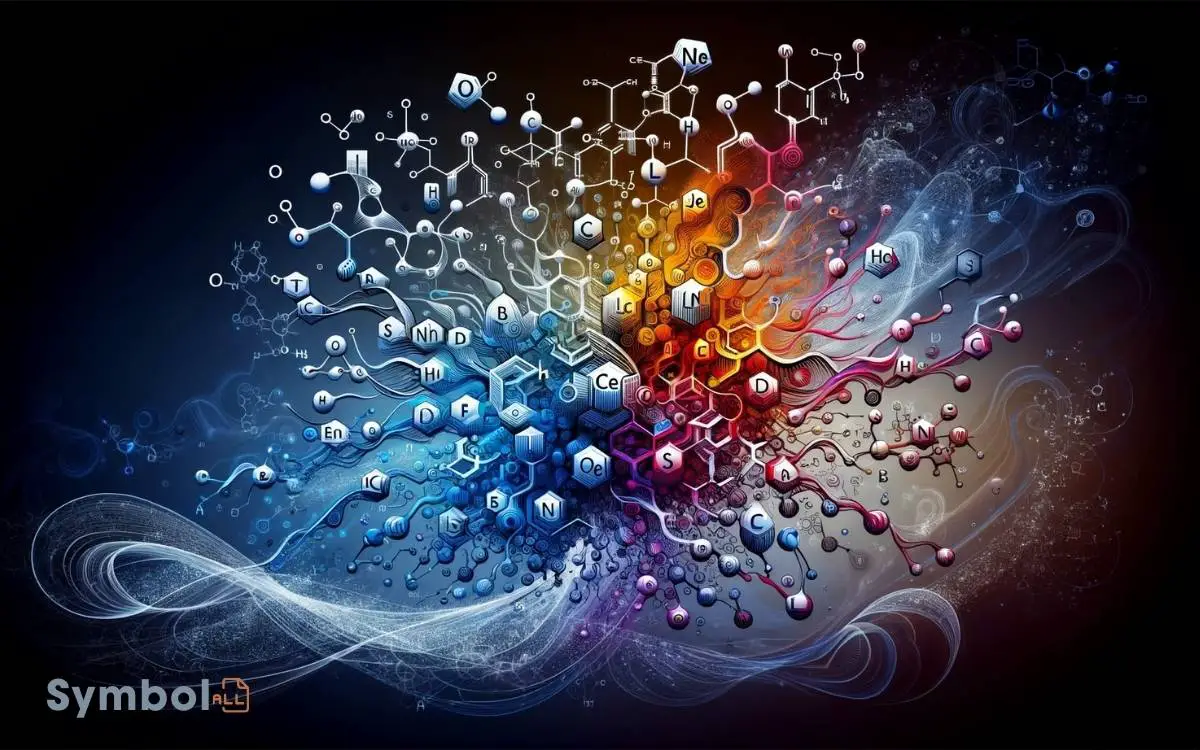Representation of a Substance Using Symbols: Compounds!
In chemistry, you’ll represent substances using symbols, an essential tool for identifying elements and compounds. These symbols, typically one or two letters with the first capitalized, avoid confusion and guarantee clarity.
You’ll decipher molecular formulas by recognizing the capitalized letters for elements and counting the atoms indicated by numbers following these symbols. This allows you to assess molecular weight and understand the substance’s composition and proportions.
Elemental notations, derived from Latin names, are the building blocks for these representations, conveying the substance’s makeup in chemical equations and compound formulas.
As you progress, the intricacies of isotopic symbols and navigating intricate compounds’ structures will reveal deeper insights into the molecules’ properties and reactions.

Key Takeaways
The Basics of Chemical Symbols
Chemical symbols, playing an essential role in chemistry, allow you to swiftly identify elements and compounds in a formula with precision and clarity. Each symbol, typically made up of one or two letters, represents a specific element. Chemical symbols and their purpose extend beyond simple identification; they also facilitate universal communication among scientists, ensuring consistency across different languages and regions. For example, H represents hydrogen and O stands for oxygen, making H₂O immediately recognizable as water worldwide. By using chemical symbols and their purpose effectively, chemists can streamline complex equations and convey intricate chemical reactions with ease.
The first letter is always capitalized, guaranteeing you don’t mistake it for a lowercase letter that could represent a different element. When a symbol consists of two letters, the second is always lowercase, further distinguishing each element without any confusion.
This systematic approach makes sure you can accurately interpret the substance at hand without any ambiguity.
Understanding these fundamentals is vital for diving deeper into the realm of chemistry, as it establishes the groundwork for recognizing how elements combine and interact in more intricate formulas.
This knowledge is indispensable for anyone seeking to grasp the basics of chemical nomenclature and its applications.
Deciphering Molecular Formulas
Understanding molecular formulas often serves as the next important step in mastering the language of chemistry, enabling you to explore the composition and proportions of elements within compounds accurately.
As you investigate this aspect, you’ll realize it’s not just about recognizing the symbols but about understanding the structure and relationships they denote.
To guide you in deciphering molecular formulas:
- Identify the elements: Look for the capitalized letters, which represent the chemical elements involved.
- Count the atoms: Numbers immediately following symbols indicate the quantity of atoms of each element.
- Assess molecular weight: Summing the atomic weights of all atoms gives the pivotal weight, essential for calculations.
Understanding Elemental Notations
To effectively navigate the world of chemistry, you’ll need to grasp elemental notations, which serve as the building blocks for representing substances. These notations are systematic and precise symbols assigned to each chemical element.
They’re not arbitrary but reflect a deep understanding of the elements’ properties and their interactions.
| Element | Symbol |
|---|---|
| Hydrogen | H |
| Oxygen | O |
| Carbon | C |
| Nitrogen | N |
Each symbol is a concise representation, usually derived from the element’s Latin name, ensuring consistency across languages and scientific disciplines.
You’ll encounter these symbols in various contexts, from chemical equations to compound formulas, where they play a fundamental role in conveying the composition of substances.
Mastering them is essential for anyone looking to understand or communicate within the domain of chemistry.
The Role of Isotopic Symbols
In addition to elemental symbols, isotopic symbols play a vital role in accurately representing the subtle variations within elements.
These symbols provide essential information about the specific isotopes of an element, allowing you to distinguish between atoms with different numbers of neutrons.
Understanding isotopic symbols is essential for:
- Analyzing chemical reactions where different isotopes may behave slightly differently.
- Interpreting mass spectrometry results, which often rely on detecting differences in isotopic masses.
- Studying nuclear chemistry, where isotopes play a key role in reactions within nuclear reactors or in radiometric dating techniques.
Isotopic symbols enrich your understanding of elements beyond their mere presence in a compound. They offer a deeper insight into the nuanced behaviors and properties of substances, enabling a more sophisticated analysis and discussion of chemical phenomena.
Navigating Complex Compounds
Having explored the significance of isotopic symbols, let’s now focus on how to navigate the complexity of compounds.
You’ll encounter molecules that seem bewildering at first glance. However, understanding their structure involves recognizing patterns and applying systematic methods.
Start by identifying the backbone of the compound, which typically involves carbon atoms in organic chemistry. Next, pinpoint functional groups, as they’re key to the molecule’s properties and reactivity.
Pay attention to prefixes, suffixes, and numbers in the compound’s name; they reveal structural details, such as the number of carbon atoms and the position of functional groups.
Conclusion
In wrapping up, think of chemical symbols like a universal language, meticulously mapping the vast world of substances. Just as a compass guides a sailor through uncharted waters, these symbols navigate us through the complex landscape of chemistry.
With every molecule’s structure or isotope’s weight precisely represented, this language transforms the abstract into the tangible.
It’s a systematic dance of elements and compounds, each step calculated, each movement defined, making the invisible world of atoms and molecules visible and understandable.






